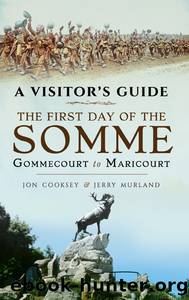The First Day of the Somme by Cooksey Jon;Murland Jerry;

Author:Cooksey, Jon;Murland, Jerry;
Language: eng
Format: epub
Tags: HISTORY / Military / World War I
ISBN: 4592078
Publisher: Pen & Sword Books Limited
Published: 2016-08-31T00:00:00+00:00
Private Thomas Goodman was one of thirteen men from the 1st Border Regiment killed on 6 April 1916.
Lieutenant Geoffrey Cather VC.
Burials began here after the German withdrawal to the Hindenburg Line in February 1917 at which point the cemetery contained 517 burials, mainly of men from the 36th Ulster and 63rd Royal Naval divisions before it was greatly expanded with casualties from the surrounding battlefields. The majority of those buried in the cemetery died on 1 July, 3 September or 13 November 1916. There are now 2,540 casualties buried or commemorated in the cemetery of which over half are unidentified. Special memorials commemorate forty-three casualties known or believed to be buried amongst them and there are a further sixteen special memorials to men known to have been buried in other cemeteries. Amongst these is Private James Atwill (Sp Mem 37) of 1/Newfoundland Regiment, who was killed on 1 July. His body was one of those brought in after the battlefield clearances, possibly from the former Y Ravine Cemetery No. 2. Another Newfoundlander is 27-year-old Captain Eric Ayre (II.E.12) from St Johnâs, whose brother, Bernard â buried in Carnoy Military Cemetery â was also killed on 1 July serving with 8/Norfolks. Three other members of the Ayre family were killed on that tragic day, 19-year-old Lance Corporal Edward Ayre (Y Ravine Cemetery), 25-year-old Second Lieutenant Gerald Ayre (Newfoundland Memorial) and 21-year-old Second Lieutenant Wilfred Ayre (Knightsbridge Cemetery).
One of the most well known of the November casualties was 21-year-old Lieutenant Hon. Vere Harmsworth (V.E.19) of the Hawke Battalion RND. He was the son of Lord Rothermere and was killed at the Beaucourt Redoubt on 13 November 1916. The RND â formed from mainly naval reservists with the addition of Kitchener volunteers â captured Beaucourt and the Beaucourt Spur during the last days of the Battle of the Ancre in November 1916 and their memorial, which was unveiled in 1922, can be seen in Beaucourt-sur-Ancre. When the RND Memorial Committee was seeking financial assistance to place a monument at Beaucourt Lord Rothermere offered to provide the necessary funding. Vere Harmsworthâs brother, Harold, died of wounds whilst serving with 2/Irish Guards in February 1918. He is buried in Hampstead Cemetery, London (WB.620).
After leaving the cemetery retrace your route to the junction and turn left to cross the railway line following the CWGC sign for 36th (Ulster) Division Memorial. You are now on Mill Road and about to cross the River Ancre. It is worth remembering that not long after the British arrived on the Somme in the summer of 1915, the entire frontage from north of John Copse at Serre all the way down to this point â the responsibility of three divisions on 1 July 1916 â was held by just two brigades of the 4th Division!
If you want to park your vehicle there is space near the two bridges that span the various pools of the Ancre. Walk up to the second bridge and look upstream to the weir where the former mill was situated.
Download
This site does not store any files on its server. We only index and link to content provided by other sites. Please contact the content providers to delete copyright contents if any and email us, we'll remove relevant links or contents immediately.
| Atlases & Gazetteers | Historical |
| Travel Maps | United States |
| World |
Goodbye Paradise(3666)
Atlas Obscura by Joshua Foer(2760)
Tokyo by Rob Goss(2346)
Borders by unknow(2143)
Lonely Planet New York City by Lonely Planet(2139)
DK Eyewitness Top 10 Travel Guides Orlando by DK(2080)
Top 10 Dubai and Abu Dhabi by DK Travel(2034)
Tomb of the Panzerwaffe: The Defeat of the Sixth SS Panzer Army in Hungary 1945 by Aleksei Isaev & Maksim Kolomiets(1810)
Rick Steves London 2018 by Rick Steves & Gene Openshaw(1793)
Dirt by Bill Buford(1577)
The Path Between the Seas by David McCullough(1543)
Atlas of Improbable Places by Travis Elborough(1477)
the fault in our stars by john green(1454)
The Travels by Marco Polo(1417)
Tokyo on Foot by Florent Chavouet(1407)
Need by Unknown(1401)
The Lives of Conn Smythe by Kelly McParland(1378)
The Lord of the Rings: The Fellowship of the Ring, the Two Towers, the Return of the King by J. R. R. Tolkien(1348)
Still Alice by Lisa Genova(1341)
